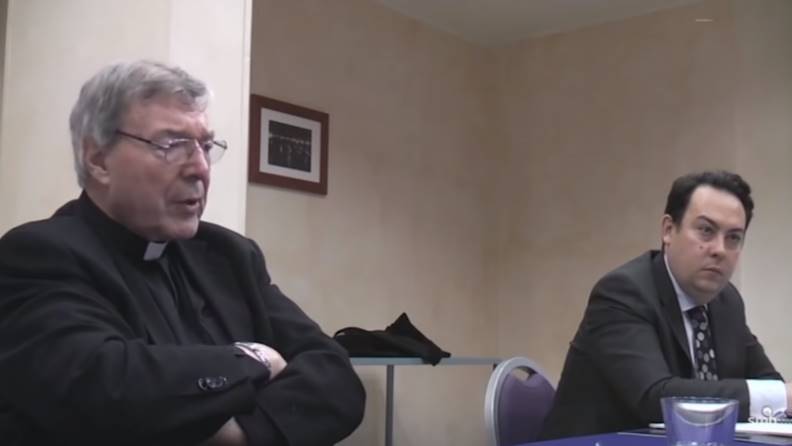|
The Catholic Church: A village that enables child abuse
By Suresh Ruberan
[with video] What is present in the corridors of Catholic Church culture that enables such sexual abuse of children and such heavy repudiation of victims and their families? This is a poignant question given the George Pell's recent failed appeal – the highest-ranking official in the Catholic Church to be convicted of child sex abuse – and the radical pushes for reform coming from Catholics themselves, as well as the growing despair of conflicted Catholics. From the movie Spotlight, which built momentum to confront Catholic Church culture, comes a quote, "If it takes a village to raise a child, it takes a village to abuse one". 7% of Catholic priests are alleged perpetrators. This number does not constitute a village. So, what is it about the Church’s handling of these cases that makes it such a bludgeoning mess? It is the culture that the Church is steeped in, and responds with, that is a significant contributor to the violence of child sex abuse. A culture helps form a village: a village that enables child abuse. With Australia trying to combat the scourge of family abuse, changing Australian culture is a significant strategy for reducing the prevalence of family abuse. Men’s behaviour change Programs are for men who perpetrate family abuse, incorporating a variety of abuse including emotional, sexual, physical and verbal. As a facilitator of Men’s behaviour change Programs, I notice similarities between a culture that enables family abuse and a culture that enables sexual abuse of children within the Church (I am not making any other comparisons between perpetrators of family abuse and perpetrators of paedophilia). Here are some similarities between the culture of family abuse in Australia and the culture of the Catholic Church, with view to changing the latter: The blind spot of privilegeMen have privileges over women and children. Men are over-represented in film and media and regarded more positively into older age than women are;the gender pay gap significantly favours men; men understandably feel safer when travelling during the day or night; men are more often in positions of power; men are able to show skin more openly without judgement (including their nipples, their unshaved armpits and legs); and men’s bodies are less scrutinised in public. These entitlements from male privilege create a culture to see women and girls as less than, which can enable gendered abuse. Discussing privilege in behaviour change programs allows men to recognise their sense of entitlement and how it fostered their abusive behaviour and it helps them to develop empathy for those they have abused. Acknowledging privilege though is hard to do as privilege is usually invisible to those who benefit from it. There is an added hurdle to accepting privilege: 'when you’re accustomed to privilege, equality feels like oppression'. Clerics have privileges over laypeople (including children). Clericalism emphasises the authority of clerics (largely male), from popes to priests and has been identified as a factor contributing to the child abuses. The hierarchy of the Church, down to the laity, can begin to recognise the privilege and entitlement they have and start to express empathy for their victims. Use of power and controlThe power and control wheel is used to highlight the different ways men can use power and control over the family. It can be strongly argued that the Catholic Church culture uses all eight facets of the wheel to exert their power and control:
When men are able to identify the ways they can control a relationship, the equality wheel shows the tenets of a healthy relationship. Most of these apply as values for a future, healed Church: non-threatening behaviour, respect, trust and support, honesty and accountability, responsibility, as well as negotiation and fairness. The costs of non-violent behaviourThose who abuse would not do so unless there are benefits to being abusive. Men behaving violently has long-term costs (relationship breakdowns) with spurious short-term benefits ( release of anger). Non-violent behaviour, on the other hand, often has short-term costs (losing an argument) with long-term benefits (better relationships). The Church’s violent response of silencing victims has drastic long-term effects on the victim’s health, their families and the Church’s reputation with the short-term benefit of protecting the reputation of the Church. If Church culture became non-violent, transparent, cooperated with legal entities and heard victim-survivors, then the short-term cost would be the negative reputation of the Church and the long-term benefits would be better healing for victims, laypeople and a more vibrant church. This should be the motivation for cultural change within the Church. Healthy sexual expressionMen are socialised by gender roles and toxic masculinity (angry behaviour, lack of vulnerability, feeling entitled and having the urge to dominate and intimidate) not to express deeper feelings. For men in behaviour change groups identifying and communicating their feelings promotes non-violent behaviours, the greater likelihood of seeking consent and of healthier sexual expression. Priests and other religious orders, through Church culture and the mandatory vow of celibacy, are taught not to express sexual feelings. Similarly, allowing priests to be in a committed, sexual relationship tells the Catholic laity that sexual expressions are healthy and provides a valuable role model. That Jesus had to be conceived by the Virgin Mary indicates the negative light with which Church culture views sex. A healthy culture of sexual expression transforms a weighted culture of sexual repression within the Church. Cultural change will be possible within the Catholic Church when clerics and laypeople acknowledge privilege, recognise the use of power and control, accept the short-term costs of non-violent behaviour, and without shame, support the value of healthy sexual expression. Catholic Church culture could then start to regain some of its lost or wandering flock and move away from child abuses and cover-ups, to become a village capable of raising healthy children.
|
.
Any original material on these pages is copyright © BishopAccountability.org 2004. Reproduce freely with attribution.
